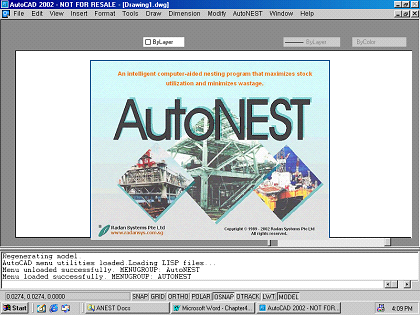The step-by-step work flow of AutoNEST in the AutoCAD environment is as follows:
(1) Starting AutoNEST
To run AutoNEST, click the Start button (located at the lower-left corner of screen) of your Windows and select Programs à AutoNEST for AutoCAD 200X.
This will launch AutoCAD and AutoNEST. Next, you will see an additional pulldown menu titled “AutoNEST”, located between the “Modify” and “Window” pulldowns.

(2) Create Parts
| Using AutoCAD interactive DRAW commands, the user can construct the geometry of each part that needs to be nested. Use the SavePart or MirrorPart commands to save each part. Besides SavePart , the user can also use ConvertPart or ImportRectPart to convert DXF or Excel files respectively into AutoNEST’s parts. |
| (3) | Create Task |
This is the task definition stage. Through Windows dialog boxes, the particulars of parts required to be nested onto specified stock sheets are specified. Details such as edge allowances, cutting gaps and other nesting criteria are being specified here. The command name is TaskEdit.
(4) Nesting
After having defined the nesting requirements in the previous stage, Nesting can now be invoked to compute the layout solutions. The resulting layouts are automatically converted into DXF format and displayed onto the current AutoCAD session. Two text files are also generated to reflect the nesting results.
| (5) | UpdateNEST |
Once a nested layout is displayed onto the current drawing, you can further edit it based on your better judgment and experience using AutoCAD’s move, copy, rotate or delete commands. This process will be invisible to AutoNEST, as such AutoNEST needs to be “updated” so that new utilization percentages of the stock sheet can be displayed. This is achieved via UpdateNEST command.
| (6) | ViewNEST |
This command allows you to review layouts of previously nested tasks within current Task/ Parts directory.
| (7) | Auto-Bridge |
You can define the Bridge specifications in TaskEdit. To view the bridged nested layouts, select either ViewNEST or Nesting / BatchNesting commands.
See Command Flow Chart of AutoNest